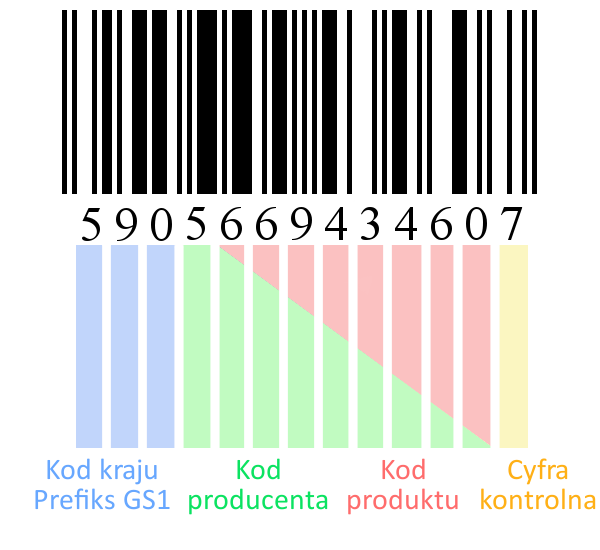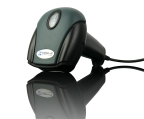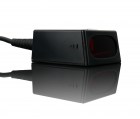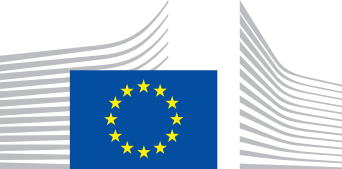Currently, almost all products available in the store have their own unique code. The most common of these is the EAN type code, usually between eight and thirteen numbers in length. For many, it is just a sequence of random numbers, but in fact, each individual number has a specific meaning.
EAN type codes were introduced in 1977 by the European Article Numbering (EAN) organization. They are based on the previously introduced UPC codes used in the United States and Canada. In 2005, the international organization GS1 used the unification of these two codes under the abbreviation GTIN, expanded as the Global Trade Item Number.
The code has a fixed length and four EAN codes are successively distinguished:
- EAN-13
- EAN-8
- EAN-128
- EAN-14
Each of the codes, in addition to the data number string, also has a check number that is in the last place.
To explain this issue better, I will use the EAN-13 code example, which is undoubtedly the most popular code on everyday products. The EAN-13 numerical code consists of four areas:

1. Country code
2. Producent code
3. Product code
4. Check digit
The first three digits represent the country code, also known as the GS1 Prefix. This number is the National Identifier of the GS1 Organization with which the goods are registered. Therefore, it is necessary to refute the misconceptions that this number means the country of origin of the product.
The next nine numbers are assigned to the manufacturer code and product code. The manufacturer's code is always a fixed value and is issued by the GS1 organization. Together with the GS1 Prefix, they form the GS1 Company Prefix. The characters that change within the manufacturer are the code of the individual product. It is given when registering a new product by the manufacturer. The producer code can be one to nine characters long. This depends on the number of products that a given company would like to register. For example - a company with a very wide range may have a manufacturer's short code, consisting of e.g. 3 digits, while the remaining 6 digits will allow you to register one million products. On the other hand, smaller companies can obtain a producer code with 7 characters, and the remaining two will be used to register 100 products. This allows for more effective use of the EAN13 code combination, and a company that has already used its limit of registered products can apply in the GS1 organization for a new producer code and thus obtain a new pool of available codes.
The last character is a check digit. It is generated automatically based on the previously entered string of characters. To calculate it, the modulo 10 algorithm is used, the formula of which is as follows:

Based on this formula, you can easily calculate the checksum. We print out all the digits without a checksum and multiply each digit in the odd position (first, third, fifth, etc.) by 3.
An explanation is provided below. In this case, remember to start the calculation from the end of the EAN code.

After deciding which digit is to be multiplied, the obtained numbers should be added up. In the example code it will look like this:
5 + 3 * 9 + 0 + 3 * 5 + 6 + 3 * 6 + 9 + 3 * 4 + 3 + 3 * 4 + 0 + 3 * 2 = 113
The check digit will be a digit that should be added to the result so that the number is divisible by 10 (e.g. to 82 add 8, to 224 add 6, etc.). In our case, 7 should be added to the number. And the number 7 is the check digit of the code entered earlier.
 1. Country code
2. Producent code
3. Product code
4. Check digit
The first three digits represent the country code, also known as the GS1 Prefix. This number is the National Identifier of the GS1 Organization with which the goods are registered. Therefore, it is necessary to refute the misconceptions that this number means the country of origin of the product.
The next nine numbers are assigned to the manufacturer code and product code. The manufacturer's code is always a fixed value and is issued by the GS1 organization. Together with the GS1 Prefix, they form the GS1 Company Prefix. The characters that change within the manufacturer are the code of the individual product. It is given when registering a new product by the manufacturer. The producer code can be one to nine characters long. This depends on the number of products that a given company would like to register. For example - a company with a very wide range may have a manufacturer's short code, consisting of e.g. 3 digits, while the remaining 6 digits will allow you to register one million products. On the other hand, smaller companies can obtain a producer code with 7 characters, and the remaining two will be used to register 100 products. This allows for more effective use of the EAN13 code combination, and a company that has already used its limit of registered products can apply in the GS1 organization for a new producer code and thus obtain a new pool of available codes.
The last character is a check digit. It is generated automatically based on the previously entered string of characters. To calculate it, the modulo 10 algorithm is used, the formula of which is as follows:
1. Country code
2. Producent code
3. Product code
4. Check digit
The first three digits represent the country code, also known as the GS1 Prefix. This number is the National Identifier of the GS1 Organization with which the goods are registered. Therefore, it is necessary to refute the misconceptions that this number means the country of origin of the product.
The next nine numbers are assigned to the manufacturer code and product code. The manufacturer's code is always a fixed value and is issued by the GS1 organization. Together with the GS1 Prefix, they form the GS1 Company Prefix. The characters that change within the manufacturer are the code of the individual product. It is given when registering a new product by the manufacturer. The producer code can be one to nine characters long. This depends on the number of products that a given company would like to register. For example - a company with a very wide range may have a manufacturer's short code, consisting of e.g. 3 digits, while the remaining 6 digits will allow you to register one million products. On the other hand, smaller companies can obtain a producer code with 7 characters, and the remaining two will be used to register 100 products. This allows for more effective use of the EAN13 code combination, and a company that has already used its limit of registered products can apply in the GS1 organization for a new producer code and thus obtain a new pool of available codes.
The last character is a check digit. It is generated automatically based on the previously entered string of characters. To calculate it, the modulo 10 algorithm is used, the formula of which is as follows:
 Based on this formula, you can easily calculate the checksum. We print out all the digits without a checksum and multiply each digit in the odd position (first, third, fifth, etc.) by 3.
An explanation is provided below. In this case, remember to start the calculation from the end of the EAN code.
Based on this formula, you can easily calculate the checksum. We print out all the digits without a checksum and multiply each digit in the odd position (first, third, fifth, etc.) by 3.
An explanation is provided below. In this case, remember to start the calculation from the end of the EAN code.
 After deciding which digit is to be multiplied, the obtained numbers should be added up. In the example code it will look like this:
5 + 3 * 9 + 0 + 3 * 5 + 6 + 3 * 6 + 9 + 3 * 4 + 3 + 3 * 4 + 0 + 3 * 2 = 113
The check digit will be a digit that should be added to the result so that the number is divisible by 10 (e.g. to 82 add 8, to 224 add 6, etc.). In our case, 7 should be added to the number. And the number 7 is the check digit of the code entered earlier.
After deciding which digit is to be multiplied, the obtained numbers should be added up. In the example code it will look like this:
5 + 3 * 9 + 0 + 3 * 5 + 6 + 3 * 6 + 9 + 3 * 4 + 3 + 3 * 4 + 0 + 3 * 2 = 113
The check digit will be a digit that should be added to the result so that the number is divisible by 10 (e.g. to 82 add 8, to 224 add 6, etc.). In our case, 7 should be added to the number. And the number 7 is the check digit of the code entered earlier. 














